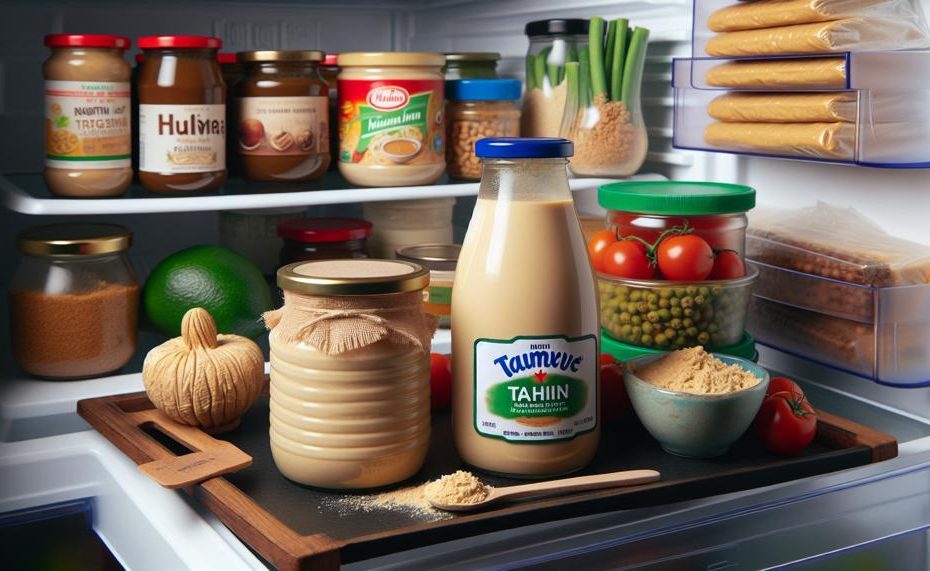This luscious and nutty spread, made from sesame seeds, is a must-have in any Middle Eastern or Mediterranean kitchen. But when it comes to storing it in the fridge, many of us are left scratching our heads. How long can tahini last?
We have all the answers for you right here. In this blog post, we’ll take a deep dive into the world of tahini and its shelf life in the fridge.
Buckle up and get ready to become a tahini pro as we cover:
- The average lifespan of tahini in the refrigerator
- Factors that can impact its freshness
- Proper storage techniques for prolonging its shelf life
- Red flags to look out for when determining if your tahini has gone bad
- Fun and delicious ways to use up leftover or expired tahini
So, Let’s dig in.
Contents
How Long Does Tahini Last?
There are multiple indicators that can help you determine if your tahini has turned bad and is no longer suitable for consumption. These include:
- Moldy appearance: Inspect the jar for any green or black spots along the edges or in the crevices of the lid. This is a clear indication that bacteria has begun to grow and the tahini should be discarded immediately.
- Dry texture: If your tahini paste has dried out and become hard, it is no longer safe to eat. This could be due to improper storage or leaving it open for too long.
- Unpleasant smell: If your tahini has a sour or off-putting odor, it is best to get rid of it. This could be a sign of bacterial growth and consuming it could lead to food poisoning.
- Rancid taste: A sharp or rancid taste is a clear indication that your tahini has gone bad and should not be consumed.
- Expiration date: Always check the expiration date on the jar. If it has passed, it is best to discard the tahini.
- Length of storage: If you have had the jar of tahini opened for more than six months, it is recommended to throw it away, even if it appears to be fine.
- Changes in consistency: While changes in consistency may occur in tahini, such as separation of oil and solids, this does not necessarily mean it has gone bad. Simply mix it thoroughly before using.
To prevent your tahini from spoiling quickly, make sure to store it properly by tightly sealing and refrigerating it after opening. It is also recommended to use it within four weeks for optimal quality. Additionally, homemade tahini will have a shorter shelf life due to the absence of preservatives.
How Long Does Homemade Tahini Last?
When kept in the refrigerator, homemade tahini typically has a lifespan of 4-6 weeks. However, its longevity can vary depending on various factors such as the ingredients used, storage temperature, and preparation method.
Factors That Affect the Shelf Life of Homemade Tahini:
- Quality of Ingredients: The freshness and quality of the ingredients used in making homemade tahini can significantly impact its shelf life. Opting for fresh, high-quality sesame seeds can extend its lifespan compared to using old or low-quality ones.
- Storage Temperature: The recommended storage temperature for tahini is in the fridge, which helps slow down the growth of bacteria and mold. If stored at room temperature, it may spoil faster.
- Method of Preparation: The way homemade tahini is prepared can also affect its shelf life. Using a clean utensil to scoop out the required amount each time and tightly closing the lid after use can prevent contamination and prolong its lifespan.
Tips for Properly Storing Homemade Tahini:
- Use an Airtight Container: To avoid exposure to air, which can lead to spoilage, store your homemade tahini in an airtight container.
- Refrigerate it: As mentioned earlier, keeping tahini in the fridge can help extend its shelf life.
- Avoid Cross-Contamination: Ensure to use a clean utensil every time you scoop out tahini from the container to prevent contamination.
- Label and Date: To keep track of when your homemade tahini was made, label and date the container before storing it in the fridge.
Table Format:
| Storage Method | Shelf Life |
| Fridge (4-6 weeks) | 4-6 weeks |
| Freezer (up to 12 months) | Up to 12 months |
How to Store Tahini?
To ensure the longest possible shelf life for tahini, it is crucial to store it correctly. Here are the top tips for storing tahini:

Opt for an airtight container
When storing tahini, use an airtight container made of glass to prevent exposure to oxygen and moisture.
This will help preserve its freshness and prevent it from becoming rancid.
Keep in a cool, dry spot
Tahini should be stored in a cool, dark place, away from sources of heat like direct sunlight or stovetops.
A kitchen cabinet or pantry is an ideal location for storing tahini.
Refrigerate after opening
While unopened tahini can be stored at room temperature, it is best to refrigerate it once opened to extend its shelf life.
This is particularly important for homemade tahini, which lacks preservatives found in store-bought versions.
Freeze for extended storage
To keep tahini for an even longer period of time, it can be frozen.
Place the tahini in an airtight container or freezer bag and store it in the freezer for up to 6 months. Remember to thaw before using.
Discard if it tastes off
Tahini has a long shelf life, but it can spoil. Signs that your tahini has gone bad include a unpleasant smell or taste, and the presence of mold. If your tahini has a bitter or sour taste, it should be discarded.
How to Tell If Tahini Is Bad?
When trying to determine if your tahini has gone bad and may no longer be safe to consume, there are a few key signs to look out for.
These indicators include:
Moldy Appearance
Keep an eye out for any green or black spots around the edges of the jar or in the crevices of the top, as this is a clear indication that your tahini has gone bad.
Not only can mold growth affect the taste and texture of the tahini, but it could also pose a health risk due to contamination.
Dry Texture
Typically, tahini has a smooth and creamy texture. However, if it appears to be completely dry or clumpy, this could be a sign that it has spoiled.
This could be caused by exposure to air or prolonged storage.
Sour or Off Smell
Fresh tahini has a mild nutty aroma, so if you notice a strong sour or off smell, this is a clear indication that your tahini has gone bad.
A noticeable change in smell should raise a red flag and prompt you to discard the product.
Rancid or Sharp Taste
Similarly, if your tahini tastes rancid or has a sharp taste, it is likely that it has gone bad. Fresh tahini has a rich and nutty flavor, so any significant changes in taste should not be ignored.
Exceeded Expiration Date
If your jar of tahini has been opened for an extended period, like a year or longer, it is best to throw it out.
Over time, tahini can spoil and become unsafe to consume.
Conclusion
In conclusion, tahini is a cherished and versatile condiment that adds a delectable nutty taste to any dish.
However, when it comes to storing it in the fridge, many of us are unsure about its shelf life. After delving into the world of tahini and its longevity in the refrigerator, we have discovered that proper storage techniques and being mindful of signs of spoilage are crucial in extending its lifespan.
So, next time you reach for your jar of tahini, remember to check the expiration date, watch out for mold or unpleasant odors, and store it correctly to savor its deliciousness for weeks or even months.





